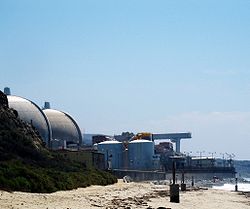Anti-nuke activists aim at San Onofre
By Joseph Perkins
Southern California Edison meets today with the Nuclear Regulatory Commission. It hopes to persuade the feds to approve its proposed license amendment for San Onofre nuclear plant, which has been offline since January 2012 because of certain wear and tear on its two reactors.
SoCal Ed, the plant’s majority owner, proposes to restart one of San Onofre’s two reactors, which is less damaged than the other. And the utility proposes to run the reactor at only 70 percent of maximum generating capacity for five months, before shutting it down again for inspections.
That’s not good enough for California’s noisome anti-nuke activists. They will be satisfied with nothing short of permanent shutdown of San Onofre, one of the Golden State’s two remaining nuclear plants (along with Diablo Canyon Power Plant in San Luis Obsipo County).
The anti-nukesters suggest that SoCal Ed’s proposed license amendment is a nefarious way to get San Onofre back online without the public having a say so. They have previously called for an “adjudicatory public hearing,” a show trial at which SoCal Ed would have to plead for the nuclear plant’s continued operation.
So bent on keeping San Onofre idle indefinitely (if not permanently), anti-nuke activists have trotted out the kind of alarmist rhetoric usually reserved for global warming.
Indeed, the radical environmentalist group Friends of the Earth warns that the nuclear plant’s two reactors “pose a unique threat to eight million Californians living within 50 miles” of the plant.
We’re talking a nuclear catastrophe of Fukishima or Chernobyl or Three Mile Island proportion.
But that’s just so much scary nonsense.
Safe
The fact is, in more than 40 years of operation, San Onofre has never been shut down for a safety violation.
Moreover, the doomsday scenario laid out by anti-nuke activists has been discounted by the Nuclear Regulatory Commission, most recently in 2010 when it calculated the odds of catastrophic failure to U.S. nuclear plants.
NRC estimated the risk of core damage to one of San Onofre’s reactors — not during routine operation, but in the event of a major earthquake — at 1 in 58,824. There’s a better chance of striking it rich on Antiques Roadshow (look it up).
Now here’s what matters in the NRC’s consideration of SoCal Ed’s proposal to restart one of San Onofre’s two reactors: Plant operators have conducted more than 170,000 inspections, bringing in nuclear experts from around the world.
If those experts vouch for the safe restart of the one of San Onofre’s two reactors, then a decision by the NRC to reject SoCal Ed’s proposed license amendment will be driven by politics rather than science.
Yes, shutdown of San Onofre would be exceedingly costly to SoCal Ed. But the cost ultimately would be borne by the utility’s 14 million customers in the form of higher electricity rates.
Indeed, at full capacity, San Onofre’s two nuclear reactors generate nearly 2,200 megawatts, which accounts for nearly a fifth of the utility’s overall electricity production.
While SoCal Ed has managed to get by, temporarily, without San Onofre’s atoms, in the long run the nuclear plant’s output would not be easily — or inexpensively — replaced.
Certainly not by such renewable energy sources as solar or wind, which are favored by anti-nuke activists.
While SoCal Ed heavily invests in renewable energy, as mandated under California law, it is under no illusion that it is at this point a viable alternative to nuclear energy.
Not when it would take 64,000 acres of solar panels, or 59,000 acres of wind turbines, to replace the 2,200 megawatts of electricity San Onofre generates on its 84-acre site.
Maybe someday in the future, solar power, wind energy, cold fusion of some other renewable energy will be a viable alternative to nuclear energy. But until that day comes, it would be felony dumb to permanently shutter San Onofre.
Related Articles
IRS: the heart of big government
May 27, 2013 By Steven Greenhut It’s hard to believe, but the current tax scandal will eventually fade away just
Is Public Transit Bankrupt?
March 31, 2010 By KATY GRIMES With the announcement this week by Sacramento Regional Transit that it is reducing bus and train
Government octopus strangling state
August 20, 2012 By Katy Grimes If forces are at work quelling America, the best place to start would be



